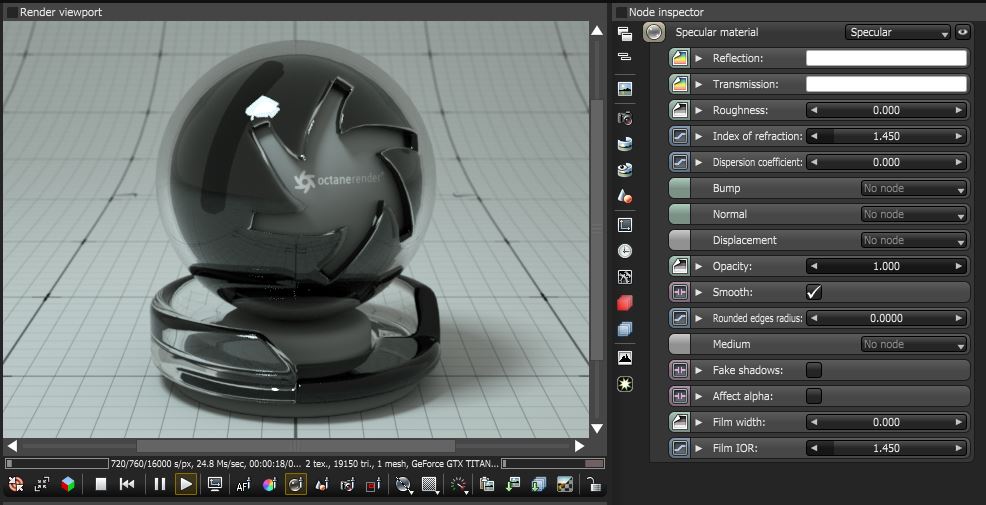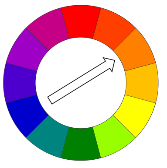
Figure 1: The Specular materialUsed for transparent materials such as glass and water. and its associated parameters.
The SpecularAmount of specular reflection, or the mirror-like reflection of light photons at the same angle. Used for transparent materials such as glass and water. material is used for transparent surfaces such as glass and water.

Figure 1: The Specular materialUsed for transparent materials such as glass and water. and its associated parameters.
Specular materials have these parameters to adjust:
Reflection
The Reflection value determines the glossy finish of the mesh. Reducing the reflectivity of a specular material will increase its transmissivity. Since OctaneRender is an unbiased GPUThe GPU is responsible for displaying graphical elements on a computer display. The GPU plays a key role in the Octane rendering process as the CUDA cores are utilized during the rendering process. accelerated render engine, it can not selectively remove one object from the reflections as what is possible with biased CPU-based render engines. Reflectivity of specular materials is also largely affected by the Index of Refraction (index attribute), for example, take a specular node with a black transmission (0 specular) and an index 0 will produce a mirror:
Roughness
The roughness determines the sharpness of the reflection that will be present on the surface of the specular material. The reflection becomes more blurry as the roughness value increases. The lowest value, 0.0, will produce the sharpest and mirror-like reflection. Simply put, this is the roughness of the surface and it affects both reflection and transmission.
Index of Refraction
The index of refraction controls the Fresnel effect of the reflection and refraction of light when it enters or exits the material. The Index represents the Index of Refraction of the material. Standard values of Index of Refraction (IOR) can be readily found via searching the internet. Glass typically has a value of 1.53 and water 1.33.
TransmissionA surface characteristic that determines if light may pass through a surface volume.
The Transmission channel which controls the light passing through the surface of the material via refraction.
Film Width
This controls the thickness of a optical, thin film on the material. This is useful in creating rainbow or oil slick effects.
Film Index
This controls the Index of Refraction of the thin film.
Bump/Normal
Both the Bump and Normal channels can load images to control the amount of bump mapping and normal mapping. The Bump channel should be set to floatimage to load a bump map. The Normal channel should be set to the image data type to load a full color normal map. The Bump channel simulates a relief using a greyscale texture interpreted as a height map while the Normal Channel distorts normals using an RGB image. Note that Normal maps take precedence over bump maps, therefore you can not use both a normal map and a bump map at the same time.
Opacity
Opacity channel controls the transparency of the material via a greyscale texture. Set the data type to alphaimage(if the image has an alpha channel) or floatimage (for black/white images) to load an image to set the transparency (use the Invert checkbox if necessary to adjust whether black or white regions are considered transparent.
Normal Smoothing
Normal Smoothing is a Boolean value that sets whether to smooth the normals of all meshes sharing that material. When “off”, the normal interpolation will be disabled and the materials can be faceted and polygonal.
Affect Alpha
This is an option to have refractions affect the alpha channel, giving specular materials alpha transparency if the alpha channel is enabled in the kernel settings. This makes reflections opaque but refractions transparent and is used to set the clearness of the surface to alpha or not. The Affect Alpha attribute is used for special cases, as this will also affect the absorption, SSS and coloured specular transmission of the material. The Affect Alpha attribute is off by default.
Dispersion Coefficient
The dispersion in OctaneRender™ is based on Cauchy’s equation which has two terms: A which is the index of refraction and B which is the dispersion coefficient. Increasing the value increases the amount of coloration and dispersion in the object and in caustics.
Medium (AbsorptionDefines how fast light is absorbed while passing through a medium. or ScatteringDefines how fast light gets scattered when traveling through the medium.)
Octane has two types of mediums, absorption and scattering, which can be used to create translucent surfaces. To use these options the Medium input of a Specular material needs to be connected to either the Absorption or Scattering medium nodes.
Absorption Medium
Absorption means that the material slightly absorbs light while passing through. The color resulting from this absorption is dependent on the distance light travels through the material. With increased distance it will get darker, and if the absorption is colored it will get more saturated. It works in a subtractive way, so users will need to configure the inverted color instead to get an absorption color desired.
Absorption works in a subtractive way so if the absorption is colored and provided that the transmission value of the material is white (allowing all light to pass through), the resulting color of the material is the complementary color of the absorption node based on the color wheel:

Example 1: The absorption color used in Box A is blue, the absorption color used in Box B is red.

Example 2: The absorption used in Box A is black, the absorption used in Box B is white. Given that the transmission color of the material on both boxes is white, the material in Box B shows no transmission of light at all because this is subtracted entirely by the white absorption.

Scattering Medium
Similar to the absorption medium but with the option to simulate sub-suburface scattering. This is a medium with single-scattering SSS, and also absorption. To use this medium, a volume needs to be created and it will not work correctly on simple surfaces. It can be used it to create true unbiased SSS, using various parameters, including scattering texture, emission texture and various other parameters. Note that this is single-scattering SSS, not multiple-scattering. It is much faster than the latter, and much more practical, although it does not allow a few things such as volumetric caustics.
The scale parameter in both mediums multiplies the absorption texture, allowing a wide range of values to be set more easily.
For applying absorption, SubSurface Scattering, and Emission refer to section on Medium Nodes in the Standalone Manual.
Fake Shadows
Fake Shadows is a Boolean value that sets the architectural glass option for all meshes sharing that material. This setting is off by default. When enabled, the specular material exhibits the characteristics of Architectural glass with its transparent feature allowing light to illuminate enclosed spaces or frame an exterior view.
Edges Rounding
This is the radius of the rounded edges that are rendered as a shading effect. The shading effect is created at render time that easily and efficiently round the sharp edges of geometric objects without modifying and reloading the geometry. The parameter is a float value and requires vertices to be welded prior to applying the round edge value. This is very useful to virtually bevel hard edges during render time especially when using low-polygon models.
DisplacementThe process of utilizing a 2D texture map to generate 3D surface relief. As opposed to bump and normal mapping, Displacement mapping does not only provide the illusion of depth but it effectively displaces the actual geometric position of points over the textured surface.
The displacement mapping allows the height of points on a surface to be adjusted based on an image value to give objects depth and detail. The displacement is a pin in the material nodes that needs to be connected to a displacement node. A displacement texture can be specified in the displacement node, as well as the amount of displacement (in meters), the offset (in meters) and the level of detail (i.e. the maximum resolution of the resampled displacement map). Image textures are supported and of RGBA images the red channel is used as height map.
Displacement only works with the texture image node over a mesh with an UV map. No other Octane nodes can be used for displacement.